Compared to many others who have simply adopted the board and cooler of the GeForce GTX 1080, Gigabyte relies on the revised design of the GeForce GTX 1070 G1 Gaming. In terms of performance, this board is more than sufficient, only with the cooler we will of course take a closer look. But while the competitors also roll out their usual top models for the GeForce GTX 1080 Ti and at least with software OC, Gigabyte simply dispenses with the Aorus cards. No factory OC, no top model – a causal chain of the logical kind.
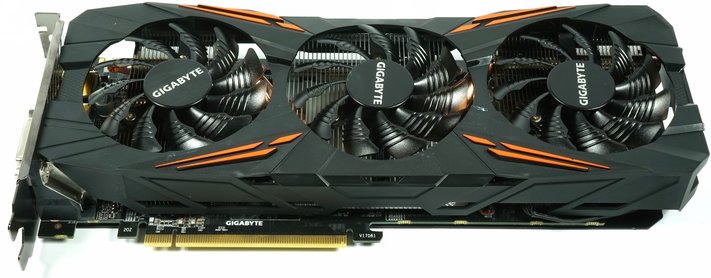
Gigabyte had already completed an OC BIOS, which had even been approved by Nvidia at the beginning. As a result, approx. 25,000 cards the assembly line – with OC-BIOS and matching label. The following two labels show the difference between the first card delivered and the current model. So if you are lucky and see one of the first cards, you get a significantly higher clock ex works.
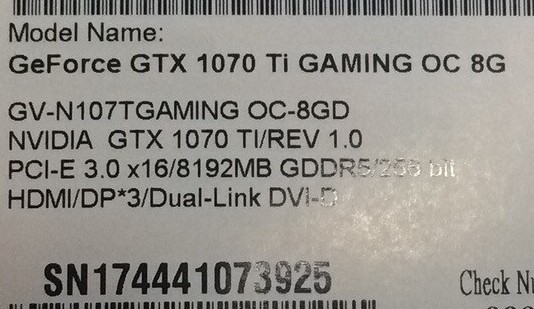 |
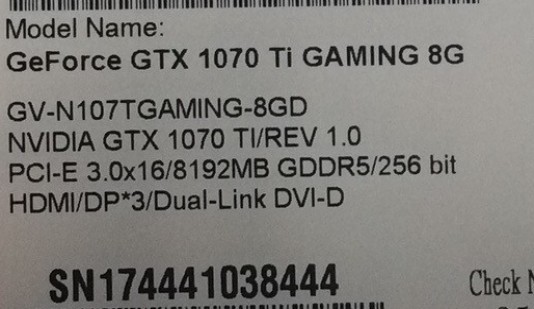 |
However, since Nvidia has not only banned this first version of the card, but has also objected to the legal use and publication of the first BIOS, we follow gigabytes' requests and only use the current card for the test.
Since the actual performance of all board partner cards of the GeForce GTX 1070 Ti ex works has to be very similar due to the fixed base and boost offset for all manufacturers, the real achieved results depend more on the actual achieved in practice. Boost cycle, and thus indirectly from the cooling and primarily also the quality of the respective chip.
Each test based on benchmark bars is therefore only a random snapshot of a single specimen. This is precisely why we have focused on the actual technical implementation of each model and have been able to document this very well with our equipment.
Within the necessary tolerance ranges, it is definitely NOT possible that the performance of a particular card could be preceded by all others. We have therefore no longer used a manufacturer's name for the benchmarks, because according to chip quality, any card from any manufacturer can tend to the lower or upper performance limit.
Unboxing, dimensions and connections
The accessories are limited to the usual three-handed as DVD and manual. We will discuss the exact board and cooling design separately later. The most important features are first summarized in a table:
| Overview of installation dimensions, features and connections | |
|---|---|
| Installation length: |
28.7 cm (slot aperture to end cover) |
| Installation height: |
10.8 cm (upper edge slot to top card) |
| Depth: |
3.5 cm (2-slot) 0.5 cm baking plate |
| Weight: |
757 grams |
| Backplate: | Yes, with cooling function |
| Cooling: | Air Vertical-aligned cooling fins |
| Fan: |
3x 8 cm fan modules (7.7 cm rotor diameter) 11 rotor blades semi-passive lyrised |
| Connections Slot blend: |
3x DisplayPort 1.4 1x HDMI 2.0 1x Dual-Link DVI-I |
| Other shots: |
2x SLI Connector |
| Power supply: |
1x 8-pin PCI-Express |
Exterior views
The radiator cover is made of anthracite-coloured matte plastic with eye-catching colour applications in orange. With a sufficient 757 grams, the G1 Gaming is a true flyweight, which makes the installation completely unproblematic. A total of three rather small 80mm fans should ensure the right passage here. The fact that the fans are so small is due to the proportions, where the length dominates the height.
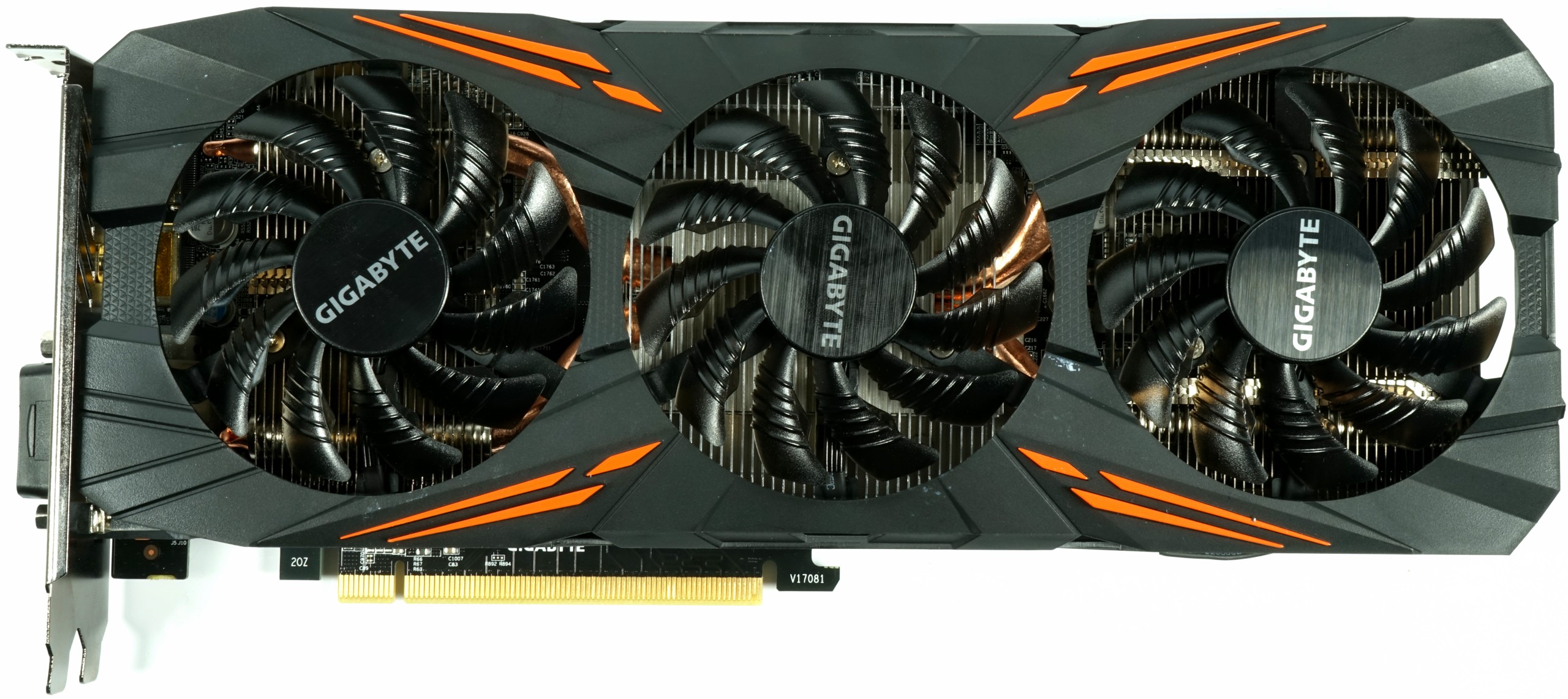 |
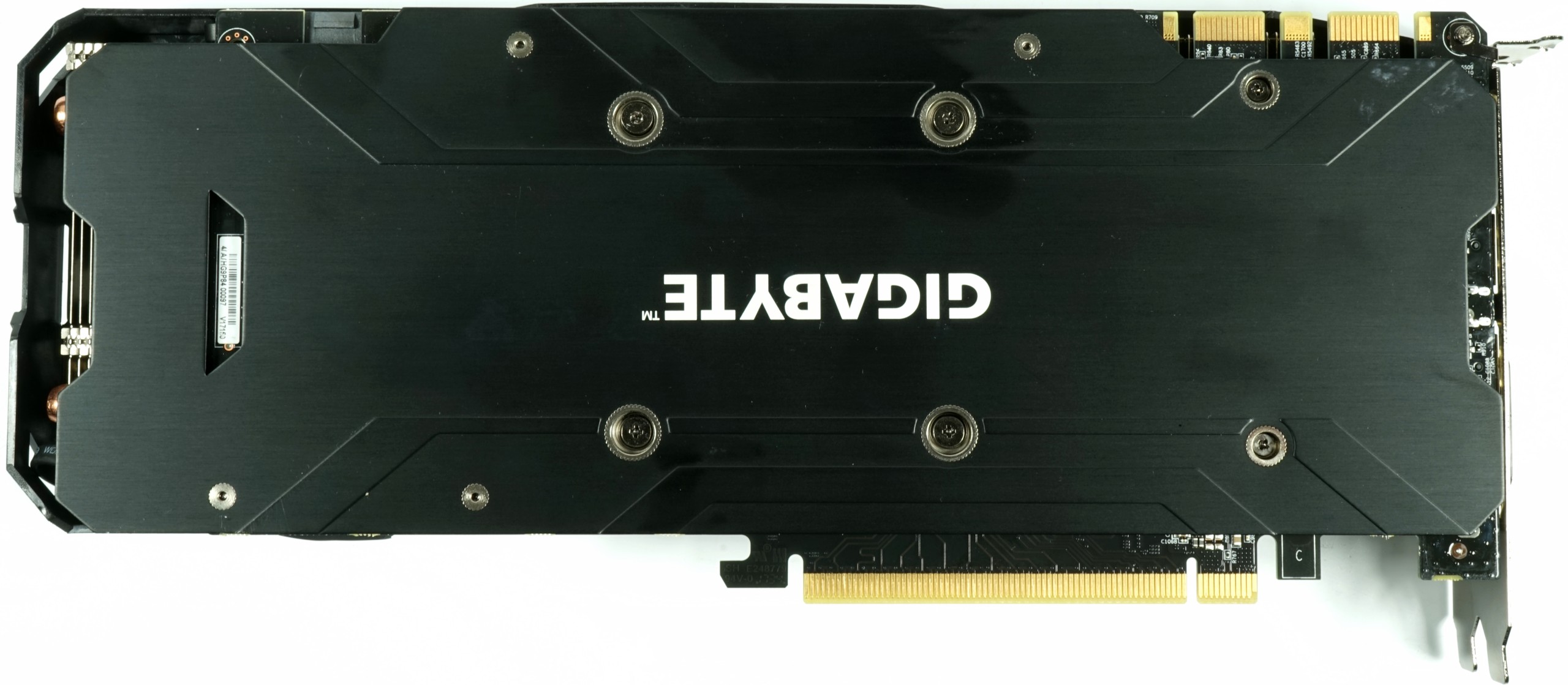 |
The back of the board is covered by a one-piece, blackened aluminum backplate, including a white, unlit gigabyte logo, you have to plan through this backplate at least another five millimeters depth on the back, which for multi-GPU systems could be important.

This backplate also requires a further five millimetres of depth on the back, which could be important for multi-GPU systems. The card is not really suitable for use in SLI systems, where every millimetre more distance between the cards is important, because the stability suffers extremely in an operation without a backplate.

The top of the card has a "gigabyte" lettering with RGB LED backlight, the fan stop indicator, and an 8-pin PCIe power supply connector at the end of the graphics card.
The just addressed end of the map shows, like its underside, that the slats are vertically aligned and thus no air flow towards the end of the map or Slot aperture goes. This is rather counterproductive in terms of heating the motherboard and air inside the housing.
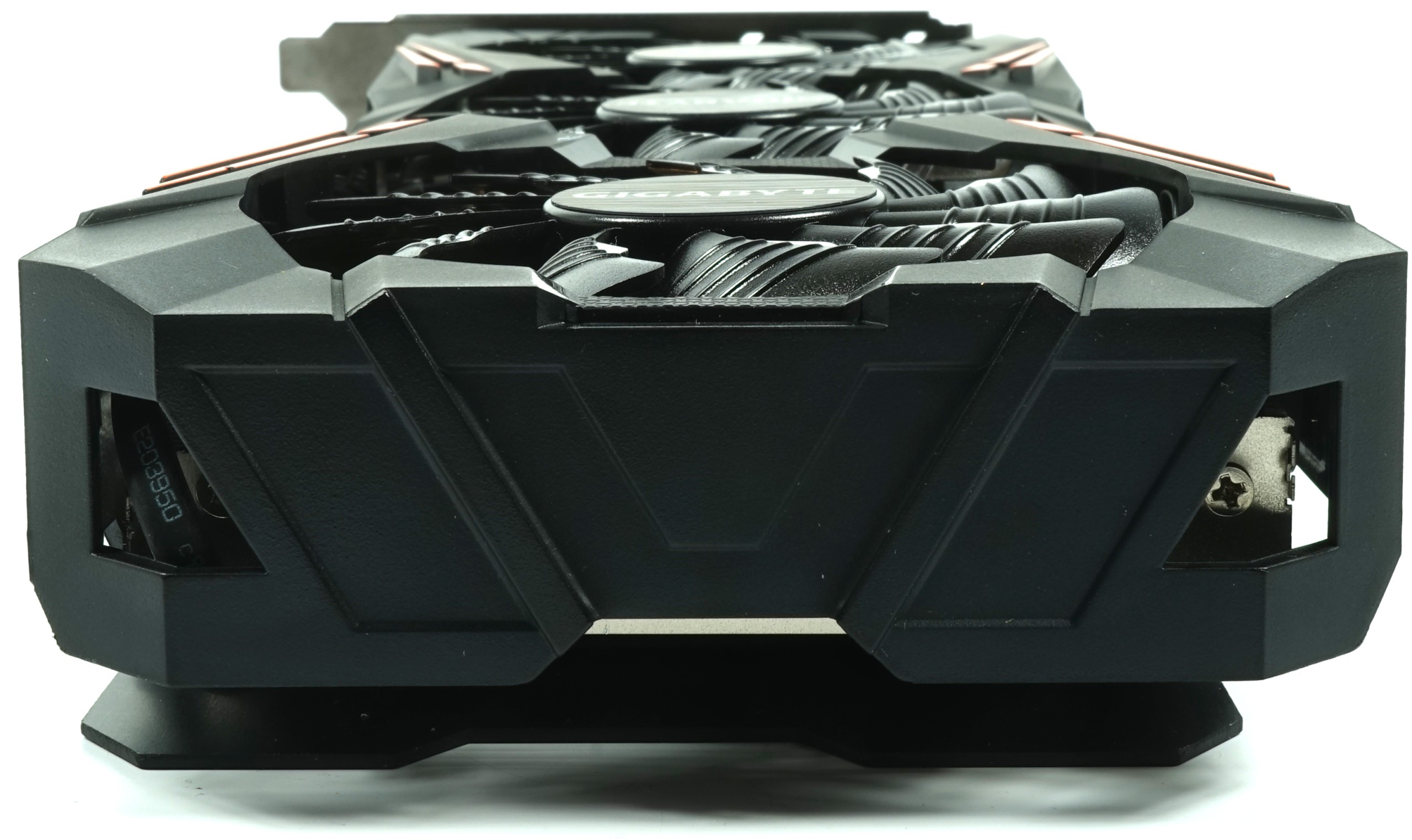 |
 |
The slot aperture offers a total of five outputs, of which a maximum of four can be operated together (multi-monitor setup). In addition to the dual-link DVI-D (no analog signal looped through!), there is an HDMI 2.0 output and three DisplayPort 1.4 ports on the back. The rest of the slot aperture has some openings for the air outlet, but they have no real function.
Specifications
Since the ex-factory specifications must be the same for all GeForce GTX 1070 Ti, the following table applies equally to all cards:
| Gpu |
GeForce GTX 1080 (GP104) |
GeForce GTX 1070 Ti (GP104) | GeForce GTX 1070 (GP104) |
|---|---|---|---|
| Sms |
20 | 19 |
15 |
| CUDA Cores |
2560 | 2432 |
1920 |
| Base Clock |
1607 MHz |
1607 MHz |
1506 MHz |
| GPU Boost Clock |
1733 MHz | 1683 MHz |
1683 MHz |
| GFLOPs (Base Clock) |
8228 | 7816 |
5783 |
| Texture Units |
160 | 152 |
120 |
| Texel Fill Rate |
277.3 GT/s | 244.3 GT/s |
201.9 GT/s |
| Memory Data Rate |
10 Gb/s | 8 Gb/s |
8 Gb/s |
| Memory Bandwidth |
320 GB/s | 256 GB/s |
256 GB/s |
| Rops |
64 | 64 |
64 |
| L2 Cache |
2MB | 2MB |
2MB |
| Tdp |
180w |
180w |
150w |
| Transistor |
7.2 billion | 7.2 billion |
7.2 billion |
| The Size |
314 mm2 | 314 mm2 | 314 mm2 |
| Process Node |
16nm | 16nm | 16nm |
Test system and measurement methods
The new test system and the methodology have already been described in great detail in the basic article "How We Test Graphics Cards" (English: "How We Test Graphics Cards") and therefore, for the sake of simplicity, we now only refer to this detailed Description. So if you want to read everything again, you are welcome to do so. However, we have improved CPU and cooling once again in order to largely exclude possible CPU bottle necks for this fast card.
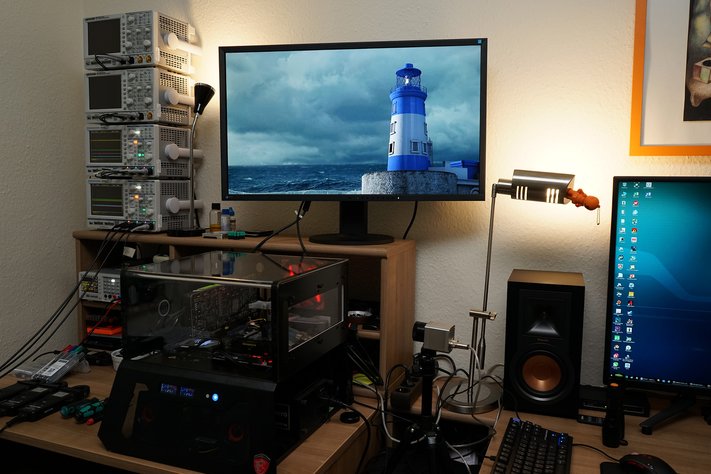
If you are interested, the summary in table form quickly provides a brief overview:
| Test systems and measuring rooms | |
|---|---|
| Hardware: |
Intel Core i7-6900K -4.3GHz MSI X99S XPower Gaming Titanium Corsair Vengeance DDR4-3200 1x 1 TByte Toshiba OCZ RD400 (M.2, System SSD) 2x 960 GByte Toshiba OCZ TR150 (Storage, Images) Be Quiet Dark Power Pro 11, 850-watt power supply Windows 10 Pro (all updates) |
| Cooling: |
Alphacool Ice Block XPX Alphacool Ice Age 2000 Chiller 2x Be Quiet! Silent Wings 3 PWM (Closed Case Simulation) Thermal Grizzly Kryonaut (for cooler change) |
| Housing: |
Lian Li PC-T70 with expansion kit and modifications Modes: Open Benchtable, Closed Case |
| Monitor: | Eizo EV3237-BK |
| Power consumption: |
non-contact DC measurement on the PCIe slot (Riser-Card) non-contact DC measurement on the external PCIe power supply Direct voltage measurement on the respective feeders and on the power supply 2x Rohde & Schwarz HMO 3054, 500 MHz multi-channel oscillograph with memory function 4x Rohde & Schwarz HZO50, current togor adapter (1 mA to 30 A, 100 KHz, DC) 4x Rohde & Schwarz HZ355, touch divider (10:1, 500 MHz) 1x Rohde & Schwarz HMC 8012, digital multimeter with storage function |
| Thermography: |
Optris PI640, infrared camera PI Connect evaluation software with profiles |
| Acoustics: |
NTI Audio M2211 (with calibration file) Steinberg UR12 (with phantom power for the microphones) Creative X7, Smaart v.7 own low-reflection measuring room, 3.5 x 1.8 x 2.2 m (LxTxH) Axial measurements, perpendicular to the center of the sound source(s), measuring distance 50 cm Noise in dBA (Slow) as RTA measurement Frequency spectrum as a graph |
































Kommentieren